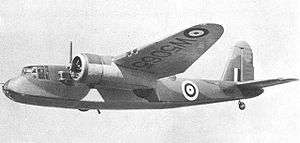Blackburn Botha
| B.26 Botha | |
|---|---|
 | |
| Blackburn B.26 Botha | |
| Role | Torpedo bomber |
| Manufacturer | Blackburn Aircraft |
| First flight | 28 December 1938 |
| Introduction | 12 December 1939 |
| Retired | September 1944 |
| Primary user | Royal Air Force |
| Number built | 580 |
|
| |
The Blackburn B.26 Botha was a British four-seat reconnaissance and torpedo bomber. It was built by Blackburn Aircraft at its factories at Brough and Dumbarton, as a competitor to the Bristol Beaufort, and entered service with the RAF in 1939. It was underpowered and was quickly withdrawn from operations.
Development and design
In September 1935, the British Air Ministry issued specification M.15/35, for a three-seat twin-engined reconnaissance/torpedo bomber. Two submissions that met this requirement were accepted, from Blackburn for the Botha and the Type 152 (later known as the Beaufort) from Bristol. Both were intended to use the 850 hp (634 kW) Bristol Perseus engine. The Air Ministry later revised the specification to M.10/36, which required a crew of four. The weight increase meant that both designs required more power. The 1,130 hp (840 kW) Taurus was provided for the Beaufort, but the Botha received only the Perseus X of 880 hp (660 kW).[1]
The Air Ministry ordered 442 Bothas in 1936, while also placing orders for the Beaufort. The first flight took place on 28 December 1938.[2]
The aircraft was built both at Blackburn's factory at Brough but also at a new factory at Dumbarton, Scotland. Brough built 382 aircraft and Dumbarton 200, a total of 580.
Operational history
Service testing of the Botha showed that the aircraft had several major problems. It was considered to have poor lateral stability, while the view to the side or rearward was virtually nonexistent owing to the location of the aircraft's engines, with the poor view making the aircraft "useless as a GR [General Reconnaissance] aircraft". Finally, the Botha was also underpowered.[3] Although the Botha successfully passed torpedo and mine-dropping trials, the aircraft's poor performance resulted in the decision in April 1940 to issue the Botha only to four general reconnaissance squadrons equipped with the Avro Anson, rather than the torpedo bomber squadrons previously planned.[4]
The Botha entered squadron service in June 1940 with No. 608 Squadron RAF, the only squadron that would use the Botha operationally, on convoy escort duties starting in August that year.[5] Typical bomb load on these patrols was three 100 lb (50 kg) anti-submarine bombs and two 250 lb (110 kg) general-purpose bombs.[6]
In service, the Botha proved to be severely underpowered and unstable and there were a number of fatal crashes in 1940. Both airframe and engine were subject to further development work, but it was decided to withdraw the type from frontline service. At this point, the Air Staff decided to transfer the surviving aircraft to training units, which inevitably resulted in further casualties.
Some Bothas were converted to target tugs and redesignated TT Mk.I.
The type was finally retired in September 1944. In total, 580 aircraft were built.
Variants
- Botha Mk I : Four-seat reconnaissance, torpedo bomber aircraft.
- Botha TT Mk I : Target tug aircraft.
Operators
- Royal Air Force
- No. 3 School of General Reconnaissance
- No. 24 Squadron RAF
- No. 502 Squadron RAF
- No. 608 Squadron RAF
Specifications (Botha Mk.I)

Data from The Hamlyn Concise Guide to British Aircraft of World War II [7]
General characteristics
- Crew: four
- Length: 51 ft 1.5 in (15.58 m)
- Wingspan: 59 ft (17.98 m)
- Height: 14 ft 7.5 in (4.46 m)
- Wing area: 518 ft² (48.12 m²)
- Empty weight: 11,830 lb (5,366 kg)
- Max. takeoff weight: 18,450 lb (8,369 kg)
- Powerplant: 2 × Bristol Perseus radial engine, 930 hp (694 kW) each
Performance
- Maximum speed: 216 kn (249 mph, 401 km/h)
- Cruise speed: 184 kn (212 mph, 341 km/h)
- Stall speed: 65 kn [8] (75 mph, 120 km/h)
- Range: 1,100 nmi (1,270 mi, 2,044 km)
- Service ceiling: 17,500 ft (5,335 m)
Armament
- 3 × 0.303 in (7.7 mm) machine guns (one fixed forward-firing, two in dorsal turret)
- internal torpedo, depth charges or bombs up to 2,000 lb (907 kg)
See also
- Aircraft of comparable role, configuration and era
- Related lists
References
- Notes
- ↑ Jackson 1968, p. 421.
- ↑ Mason 1994, p. 320.
- ↑ Haywood Aeroplane Monthly February 2013, pp. 77–78.
- ↑ Haywood Aeroplane Monthly February 2013, pp. 79–80.
- ↑ Haywood Aeroplane Monthly February 2013, p. 80.
- ↑ Haywood Aeroplane Monthly February 2013, p. 84.
- ↑ Mondey 1994, p. 38.
- ↑ "Botha I". Air Transport Auxiliary Ferry Pilots Notes.
- Bibliography
- Air Transport Auxiliary Ferry Pilots Notes (reproduction ed.). Yorkshire Air Museum. 1996. ISBN 0-9512379-8-5.
- Hayward, Roger (February 2013). "Database: Blackburn Botha". Aeroplane. Vol. 41 no. 2. pp. 69–85. ISSN 0143-7240.
- Jackson, A.J. (1968). Blackburn Aircraft since 1909. London: Putnam & Company Ltd. ISBN 0-370-00053-6.
- Mason, Francis K. (1994). The British Bomber since 1914. London: Putnam & Company Ltd. ISBN 0-85177-861-5.
- Mondey, David (1994). The Hamlyn Concise Guide to British Aircraft of World War II. London: Aerospace Publishing. ISBN 1-85152-668-4.
- Wixey, Ken (1997). Forgotten Bombers of the Royal Air Force. Arms & Armour Press. ISBN 1-85409-306-1.
External links
| Wikimedia Commons has media related to Blackburn Botha. |